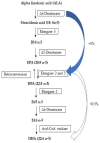Marine Sources of DHA-Rich Phospholipids with Anti-Alzheimer Effect
- PMID: 36354985
- PMCID: PMC9695993
- DOI: 10.3390/md20110662
Marine Sources of DHA-Rich Phospholipids with Anti-Alzheimer Effect
Abstract
Alzheimer's disease (AD) is a complex and progressive disease, which affects millions of people around the world. Despite the many efforts over the years to find efficient therapeutics, there is no cure yet. Nonetheless, many compounds have been proven to decrease Alzheimer's symptoms. After a short overview of the hypotheses considered in AD drug development and the drugs approved for AD treatment, which lead to symptom release, we focus on the valorization of natural marine sources that decrease AD symptoms, particularly on docosahexaenoic acid (DHA), an important component in membrane phospholipids and the most abundant n-3 polyunsaturated fatty acids (PUFA) found in gray matter of the brain and in retina and on the DHA-containing phospholipids (DHA-PLs) present in marine sources, namely fish, krill, mollusks and in fisheries and aquaculture by-products. DHA-PLs' bioactivities are presented, namely their properties in anti-neurodegeneration, neuroinflammation, as anticancer agents, as well as their benefits to obesity and visual problems. Fisheries and aquaculture by-products are also highlighted as they have a high content of DHA and DHA-rich phospholipids, can be extracted by green methodologies and should be considered in a circular economy for a healthy sustainable future.
Keywords: Alzheimer’s disease; docosahexaenoic acid; marine sources; phospholipids.
Conflict of interest statement
The authors declare no conflict of interest.
Figures





Similar articles
-
Bioavailability of fatty acids from krill oil, krill meal and fish oil in healthy subjects--a randomized, single-dose, cross-over trial.Lipids Health Dis. 2015 Mar 15;14:19. doi: 10.1186/s12944-015-0015-4. Lipids Health Dis. 2015. PMID: 25884846 Free PMC article. Clinical Trial.
-
Similar eicosapentaenoic acid and docosahexaenoic acid plasma levels achieved with fish oil or krill oil in a randomized double-blind four-week bioavailability study.Lipids Health Dis. 2015 Sep 2;14:99. doi: 10.1186/s12944-015-0109-z. Lipids Health Dis. 2015. PMID: 26328782 Free PMC article. Clinical Trial.
-
Enrichment of n-3 containing ether phospholipids in plasma after 30 days of krill oil compared with fish oil supplementation.Lipids. 2022 Mar;57(2):115-124. doi: 10.1002/lipd.12335. Epub 2022 Jan 3. Lipids. 2022. PMID: 34981516 Clinical Trial.
-
Emerging Role of Phospholipids and Lysophospholipids for Improving Brain Docosahexaenoic Acid as Potential Preventive and Therapeutic Strategies for Neurological Diseases.Int J Mol Sci. 2022 Apr 2;23(7):3969. doi: 10.3390/ijms23073969. Int J Mol Sci. 2022. PMID: 35409331 Free PMC article. Review.
-
Fatty acid facts, Part IV: docosahexaenoic acid and Alzheimer's disease. A story of mice, men and fish.Drug News Perspect. 2009 May;22(4):205-13. doi: 10.1358/dnp.2009.22.4.1367709. Drug News Perspect. 2009. PMID: 19536365 Review.
Cited by
-
Shotgun-Based Mass Spectrometry Analysis of Phospholipid and Triacylglycerol Molecular Species and Eicosanoids in Salmon Muscle Tissue on Feeding Microbial Oil.Mar Drugs. 2023 Dec 21;22(1):11. doi: 10.3390/md22010011. Mar Drugs. 2023. PMID: 38276649 Free PMC article.
-
Docosahexaenoic Acid as Master Regulator of Cellular Antioxidant Defenses: A Systematic Review.Antioxidants (Basel). 2023 Jun 15;12(6):1283. doi: 10.3390/antiox12061283. Antioxidants (Basel). 2023. PMID: 37372014 Free PMC article. Review.
-
Marine Fish-Derived Lysophosphatidylcholine: Properties, Extraction, Quantification, and Brain Health Application.Molecules. 2023 Mar 30;28(7):3088. doi: 10.3390/molecules28073088. Molecules. 2023. PMID: 37049852 Free PMC article. Review.
-
Production, Transport, Fate and Effects of Lipids in the Marine Environment.Mar Drugs. 2025 Jan 21;23(2):52. doi: 10.3390/md23020052. Mar Drugs. 2025. PMID: 39997176 Free PMC article. Review.
-
Crabs Eriocheir japonica and Paralithodes camtschaticus Are a Rich Source of Lipid Molecular Species with High Nutritional Value.Foods. 2023 Sep 7;12(18):3359. doi: 10.3390/foods12183359. Foods. 2023. PMID: 37761068 Free PMC article.
References
-
- Gordon R., Woodruff T.M. Neuroinflammation as a Therapeutic Target in Neurodegenerative Diseases. Elsevier Inc.; Amsterdam, The Netherlands: 2017.
Publication types
MeSH terms
Substances
LinkOut - more resources
Full Text Sources
Medical

